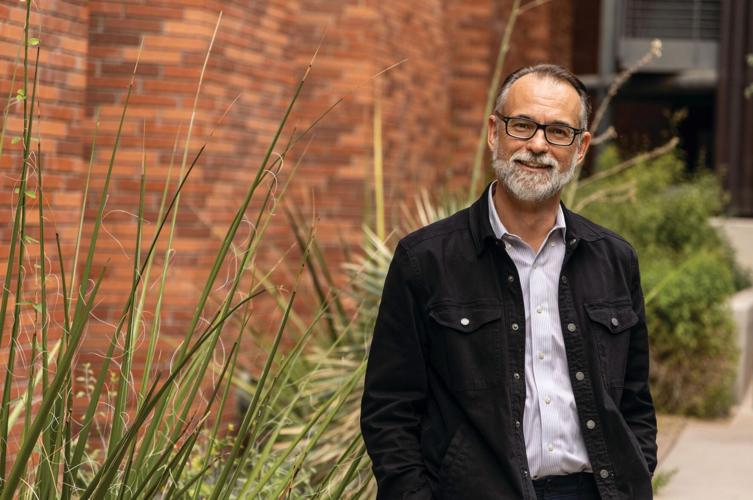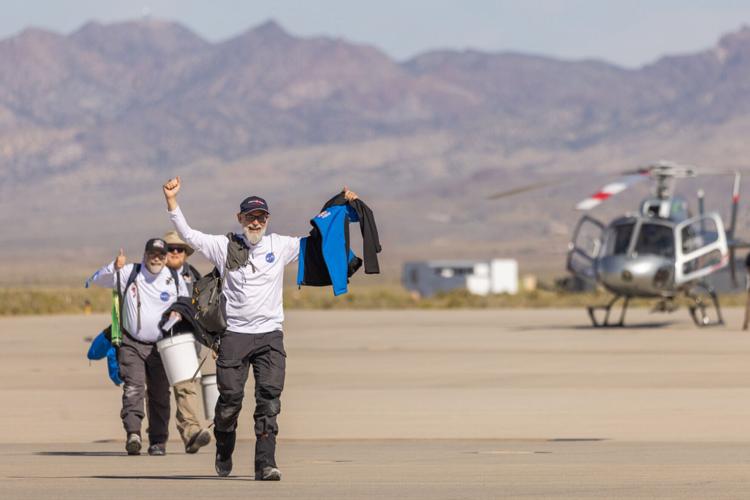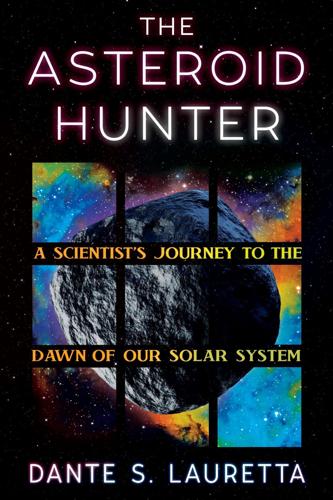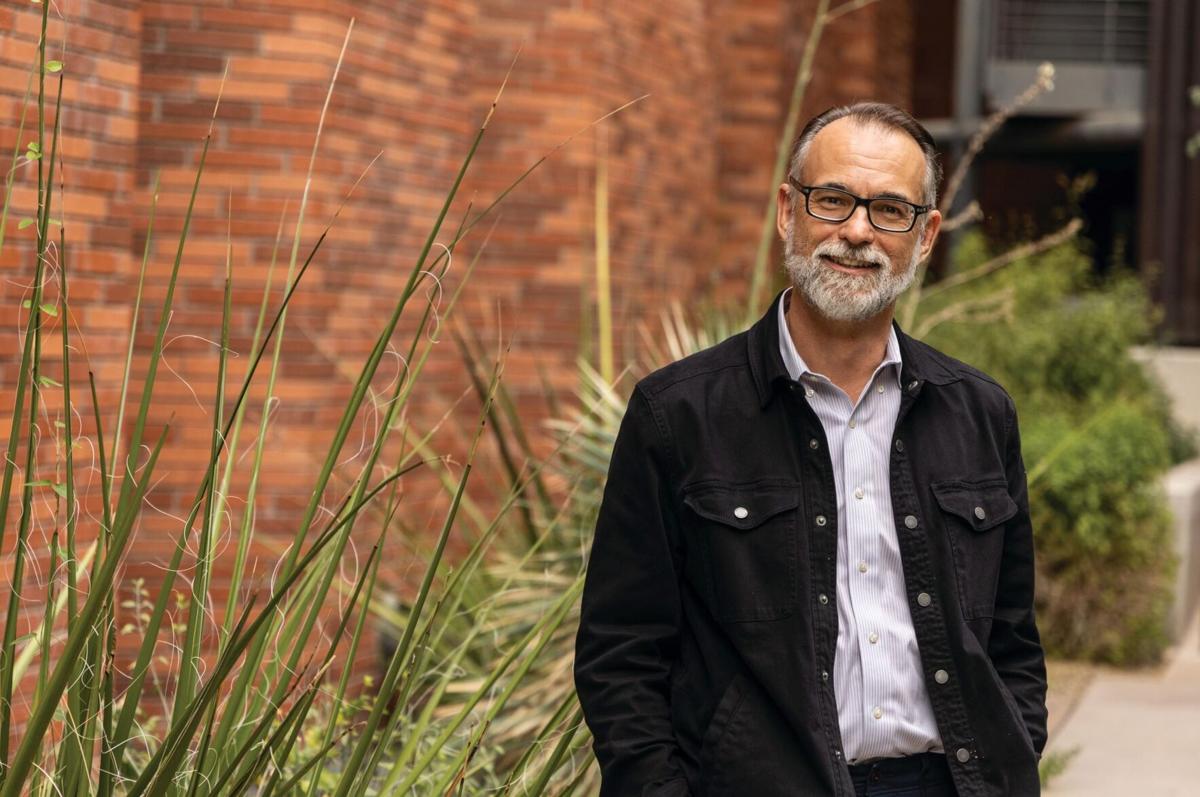Among his many talents, Dante Lauretta is an expert at multitasking.
The University of Arizona Regents Professor dictated the last chapter of his latest book from a military cargo plane as it flew him from Utah to NASA’s Johnson Space Center in Houston on Sept. 25 with a capsule full of rocks and dust from the asteroid Bennu.
“The Asteroid Hunter,” Lauretta’s new memoir about leading the Tucson-born OSIRIS-REx space mission, goes on sale March 19.
In the book’s dramatic final scene, the capsule plunges through the atmosphere like a meteor and lands under a parachute at the Utah Test and Training Range while Lauretta and the rest of the recovery team race across the desert in helicopters to greet it.

The University of Arizona’s Dante Lauretta, lead scientist for NASA’s OSIRIS-REx mission, signals success after a capsule containing materials from the asteroid Bennu landed safely in Utah on Sept. 24, 2023.
“I wanted to capture it while it was fresh,” he said of his in-flight dictation the next day. “It was so visceral and so action-packed, the words kind of wrote themselves.”
The memoir is one of two books Lauretta authored last year. The other is “Bennu 3-D: Anatomy of an Asteroid,” a coffee-table atlas of the space rock he published with legendary Queen guitarist and astrophysicist Brian May.
Lauretta will talk about both titles during separate panel discussions on March 9 at the Tucson Festival of Books on the U of A campus.

The new memoir by University of Arizona Regents Professor and OSIRIS-REx principal investigator Dante Lauretta goes on sale March 19.
“The Asteroid Hunter” chronicles his journey from a single-wide trailer in the desert north of Phoenix, where he grew up without plumbing or a television, to the U of A’s Lunar and Planetary Laboratory. That’s where he met his mentor, Michael Drake, who ran the world-famous laboratory and served as the first principal investigator for OSIRIS-REx.
Lauretta assumed leadership of the mission after Drake died in 2011, shepherding the $1.2 billion project through its launch in 2016, its brush with Bennu in 2020 and the successful return of its asteroid samples last year.
That tense and triumphant moment marks the end of “The Asteroid Hunter,” but the author’s story is far from over.
Lauretta is now busy sifting through the bounty from Bennu and writing the first of what promises to be a stack of research papers about the scientific bonanza he helped bring back from outer space.
He expects that first big paper to be finished soon, providing an overview of the entire asteroid sample and what it has revealed so far.

University of Arizona professor Dante Lauretta, right, poses with Brian May, lead guitarist for the rock band Queen, in 2019. Lauretta teamed up with May, who holds a doctorate in astrophysics, on a new 3-D atlas of the asteroid Bennu.
Already, he said, they have found tantalizing evidence hinting at the possibility that some of the particles once came into contact with large “ocean bodies.”
“The sample is fantastic. It’s exceeding my wildest dreams,” Lauretta said.
According to NASA’s final tally, the robotic spacecraft brought home 121.6 grams of regolith, more than double the amount required to declare OSIRIS-REx a success. The largest rock is about an inch and a half across, roughly the size and shape of a walnut. “It’s a beautiful particle. I call it the heart,” Lauretta said.
So far, only about a gram of material has been doled out to the mission’s U of A-led science team, which includes more than 200 researchers at labs in Tucson and around the world. But Lauretta said just that tiny amount is expected to yield 58 separate scientific papers in the coming months.
“The science is coming fast and furious,” he said. “You could take a one millimeter particle, and you could literally study it for a year.”
Lauretta said his favorite part of the process so far has been turning students loose in the lab to collect data on the material, then meeting with them afterward to discuss what they found.
When he isn’t in the lab or the classroom, Lauretta is hard at work lately running the Arizona Astrobiology Center, the U of A’s new hub for research on the existence and evolution of life in the universe.
He described the center, which was launched in October, as “a natural extension of the OSIRIS-REx activities.” After all, U of A researchers originally chose Bennu as their target because they thought the carbon-rich asteroid could contain clues about the origins of the solar system and maybe life on Earth.
Since his cargo plane flight to Houston in September, Lauretta has written a second epilogue to “The Asteroid Hunter.” In it, he describes the unlikely reunion in a lab in Tucson between twin carbon atoms that were separated billions of years ago — one to wander the vacuum of space, the other destined for a green planet and, eventually, the body of a scientist.
Though he’s still plenty busy these days, Lauretta said his life since last year’s capsule landing is “much lower stress.”
“We’ve got our sample. We’re in the lab. We’re doing science,” he said. “That’s why I did all this to begin with.”
Samples from the asteroid Bennu dropped into Utah’s western desert Sunday morning, as the University of Arizona-led OSIRIS-REx space mission came to an end. Video courtesy of FOX13.








